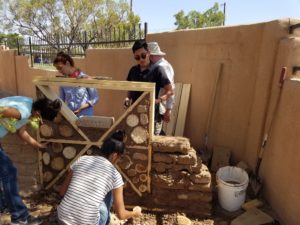Engaging Bodies, Minds, and Cultural Identities

To view the photo-rich magazine version, click here.
Originally appears in the Winter 2018 issue.
Four years ago, a group of educators, community organizers, and medical and environmental professionals met around a dinner table to talk about getting involved in the education of our youth. We discussed two of the many causes for the high dropout rate: the curriculum is too often disconnected from the students’ lives and cultures; and there is a severe lacking of hands-on and community-based learning. Toward the end of our conversation, we decided we had to do something to reverse these trends. We needed to be the village in the African proverb “it takes a village to raise a child” and pool our resources. Every year since that dinner meeting, we’ve worked collaboratively to create an eight-week hands-on experiential summer program and subsequent year-round internship program for high school students, based out of Rio Grande High School in Albuquerque, New Mexico.
The summer program curriculum is focused on water conservation, environmental restoration, sustainable agriculture, and sustainable building/planning, which students learn through hands-on community-based projects. Considering that we live on an arid, high-elevation desert, the centerpiece of our curriculum is water. Recent events across the country (and world) — from lead contamination issues in Flint, Michigan, to the indigenous-led protection of water at Standing Rock, North Dakota — helped solidify our belief that water as a curriculum topic should be front and center.
We work with students from predominantly Mexican/Chicano and Native American communities, so we try to integrate these particular cultural histories, identities, and realities as much as possible. The cultures of these students are typically absent from the science curriculum, or the curriculum of any other subject, which motivated us to adopt the group name Querencia Institute (QI). Querencia is an old Spanish word that roughly translates into ‘love of place,’ a concept that has deep cultural roots across New Mexico and the Southwest, but is an ancient concept that resonates across all cultures and communities that have spent significant time connecting with the land. We believe that by interweaving cultural perspectives into the sciences of water, land, and food, we can catalyze student interests to pursue STEM-related careers and/or academics, as well as help them to see their own cultures’ contributions to the scientific fields. This, in turn, helps promote a sense of confidence in who they are, and a sense of place, both of which are essential on so many levels.
This content is restricted to subscribers only.
If you are not yet a subscriber, please consider taking out a subscription here.
If you are an existing subscriber, kindly log in or contact us at info@greenteacher.com for more information.





